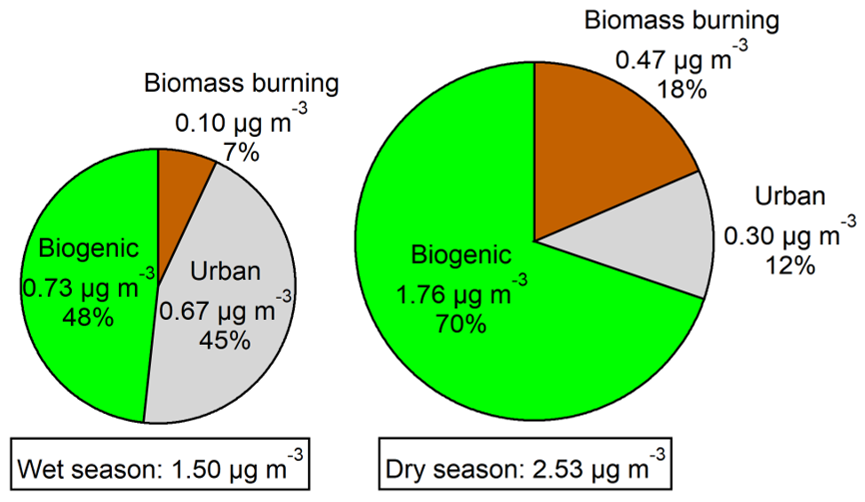Unmeasured species are major contributors to SOA formation in the Amazon
Submitter:
Jimenez, Jose-Luis — University of Colorado
Area of research:
Aerosol Processes
Journal Reference:
Science
Secondary organic aerosol (SOA) was formed by oxidizing ambient air in an oxidation flow reactor (OFR) during the wet and dry seasons downwind of Manaus, Brazil, during GoAmazon2014/15 to investigate the sources of gases present in the atmosphere that can form SOA. The main sources were quantified, with important contributions from biogenic, but also urban and biomass burning, sources. Typically only a small fraction (10-50%) of the SOA-forming gases were measured/speciated with available instrumentation, pointing to a large contribution from semivolatile and intermediate volatility gases.
Impact
The sources and formation of atmospheric SOA remain poorly understood. This innovative real-time measurement of “potential SOA” has highlighted the important role of elusive semivolatile and intermediate-volatility gases in SOA formation in the atmosphere, and demonstrated the versatility and usefulness of OFRs for studying a variety of atmospheric processes including SOA formation.
Summary
SOA has an important impact on climate forcing, but its sources are poorly understood. SOA formation from ambient air was studied using an oxidation flow reactor (OFR) coupled to an aerosol mass spectrometer (AMS) during the wet and dry seasons during the GoAmazon2014/15 field campaign. Ambient air was aged in the OFR over ranges from hours to days/weeks of equivalent atmospheric aging. The amount of SOA formed ranged from 0 to as much as 10 µg m-3, depending on the amount of SOA precursor gases in ambient air. Typically, more SOA was formed during nighttime than daytime, and more from OH than from O3 oxidation. SOA yields of individual organic precursors were measured with the OFR by standard addition into ambient air, and confirmed to be consistent with published environmental chamber-derived SOA yields. The hygroscopicity of the OA increased with OH aging and increasing elemental O:C up to O:C~1.0, and then unexpectedly decreased as O:C increased further. While measured ambient gas precursors were sufficient to explain the amount of SOA formed from O3, they could only explain 10–50% of the SOA formed from OH. This is consistent with previous OFR studies that showed that typically unmeasured semivolatile and intermediate volatility gases (that tend to lack C=C bonds) are present in ambient air and can explain such additional SOA formation. To investigate the sources of the unmeasured SOA-forming gases during this campaign, multilinear regression analysis was performed between measured SOA formation and the concentration of gas-phase tracers representing different precursor sources. The majority of SOA-forming gases present during both seasons were of biogenic origin. Urban sources also contributed substantially in both seasons, while biomass burning sources were more important during the dry season.


